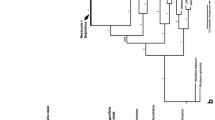Abstract.
We used ITS and trnL sequence data, analyzed separately and combined by MP, to explore species relationships and concepts in Trema (Celtidaceae), a pantropical genus of pioneer trees. Whether Trema is monophyletic or includes Parasponia is still unresolved. Three clades within Trema received moderate to high support, one from the New World and two from the Old World, but their relationships were not resolved. In the New World, specimens of T. micrantha formed two groups consistent with endocarp morphology. Group I, with smaller brown endocarps, is a highly supported clade sister to T. lamarckiana. Group II, with larger black endocarps, is poorly resolved with several subclades, including the highly supported T. integerrima clade. Both Old World clades contain Asian and African species, with three or more species in each region. Trema orientalis is not monophyletic: specimens from Africa formed a highly supported clade sister to T. africana, while those from Asia were sister to T. aspera from Australia.
Similar content being viewed by others
Author information
Authors and Affiliations
Corresponding author
Rights and permissions
About this article
Cite this article
Yesson, C., Russell, S., Parrish, T. et al. Phylogenetic Framework for Trema (Celtidaceae). Plant Syst. Evol. 248, 85–109 (2004). https://doi.org/10.1007/s00606-004-0186-3
Received:
Accepted:
Published:
Issue Date:
DOI: https://doi.org/10.1007/s00606-004-0186-3




